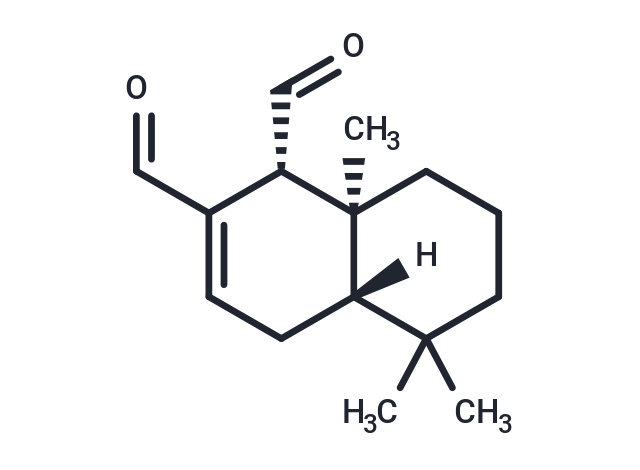Shopping Cart
Remove All Your shopping cart is currently empty
Your shopping cart is currently empty
Polygodial (Tadeonal) is an antifungal potentiator and an antibiotic, particularly against Saccharomyces cerevisiae, Candida utilis, and Sclerotinia libertiana.

| Pack Size | Price | USA Warehouse | Global Warehouse | Quantity |
|---|---|---|---|---|
| 1 mg | $42 | - | In Stock | |
| 5 mg | $98 | In Stock | In Stock | |
| 10 mg | $158 | - | In Stock | |
| 25 mg | Preferential | - | In Stock | |
| 1 mL x 10 mM (in DMSO) | $95 | - | In Stock |
| Description | Polygodial (Tadeonal) is an antifungal potentiator and an antibiotic, particularly against Saccharomyces cerevisiae, Candida utilis, and Sclerotinia libertiana. |
| In vitro | When tested on S. cerevisiae, polygodial proved to be fungicidal rather than fungistatic. When the cells of S. cerevisiae are treated in vitro with polygodial for 10 min, the cell membrane becomes severely damaged, and many vesicles, possibly formed from the fragmented cell membrane, can be observed within the cytoplasm[1]. |
| In vivo | Polygodial (0.1 to 10 mg kg(-1), i.p.) produced significant inhibition of acetic acid, kaolin and zymosan-induced writhing in mice, being about 14 to 27-fold more potent than the hydroalcoholic extract at the ID50 level[2]. |
| Synonyms | Tadeonal |
| Molecular Weight | 234.33 |
| Formula | C15H22O2 |
| Cas No. | 6754-20-7 |
| Smiles | [H][C@@]12CC=C(C=O)[C@H](C=O)[C@@]1(C)CCCC2(C)C |
| Relative Density. | 1.084 g/cm3 (Predicted) |
| Storage | Powder: -20°C for 3 years | In solvent: -80°C for 1 year | Shipping with blue ice/Shipping at ambient temperature. | |||||||||||||||||||||||||||||||||||
| Solubility Information | DMSO: 65 mg/mL (277.39 mM), Sonication is recommended. | |||||||||||||||||||||||||||||||||||
| In Vivo Formulation | 10% DMSO+40% PEG300+5% Tween 80+45% Saline: 2 mg/mL (8.53 mM), Sonication is recommended. Please add the solvents sequentially, clarifying the solution as much as possible before adding the next one. Dissolve by heating and/or sonication if necessary. Working solution is recommended to be prepared and used immediately. The formulation provided above is for reference purposes only. In vivo formulations may vary and should be modified based on specific experimental conditions. | |||||||||||||||||||||||||||||||||||
Solution Preparation Table | ||||||||||||||||||||||||||||||||||||
DMSO
| ||||||||||||||||||||||||||||||||||||
| Size | Quantity | Unit Price | Amount | Operation |
|---|

Copyright © 2015-2025 TargetMol Chemicals Inc. All Rights Reserved.